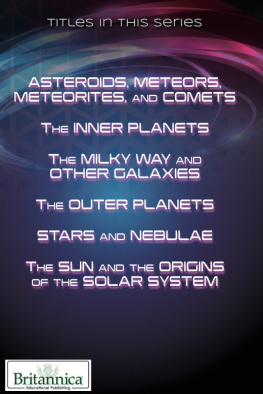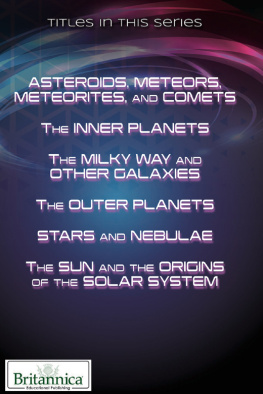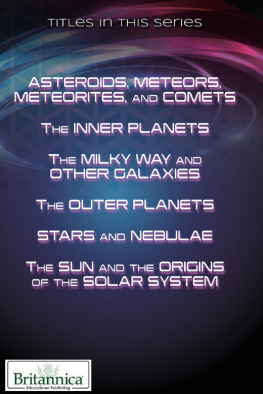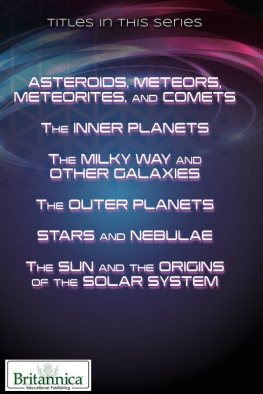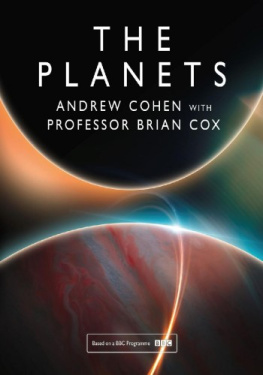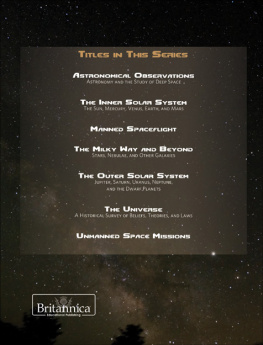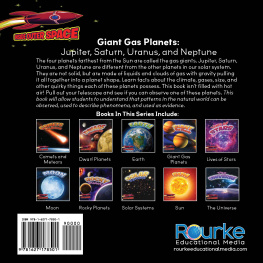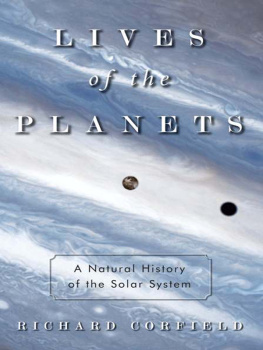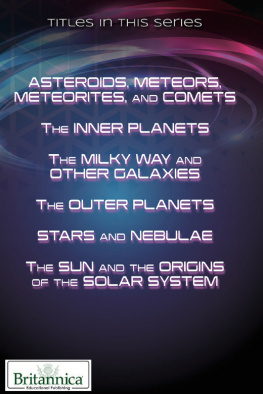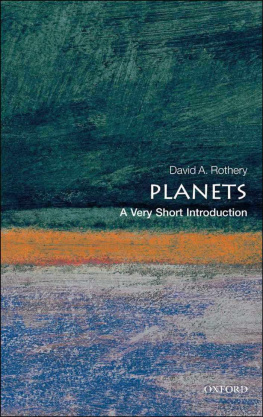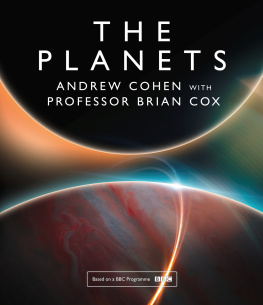Published in 2019 by Britannica Educational Publishing (a trademark of Encyclopdia Britannica, Inc.) in association with The Rosen Publishing Group, Inc.
29 East 21st Street, New York, NY 10010
Copyright 2019 by Encyclopdia Britannica, Inc. Britannica, Encyclopdia Britannica, and the Thistle logo are registered trademarks of Encyclopdia Britannica, Inc. All rights reserved.
Rosen Publishing materials copyright 2019 The Rosen Publishing Group, Inc. All rights reserved.
Distributed exclusively by Rosen Publishing.
To see additional Britannica Educational Publishing titles, go to rosenpublishing.com.
Britannica Educational Publishing
J.E. Luebering: Executive Director, Core Editorial
Andrea R. Field: Managing Editor, Comptons by Britannica
Rosen Publishing
Nicholas Faulkner: Editor
Brian Garvey: Series Designer / Book Layout
Cindy Reiman: Photography Manager
Library of Congress Cataloging-in-Publication Data
Names: Faulkner, Nicholas, editor. | Gregersen, Erik, editor.
Title: The outer planets / edited by Nicholas Faulkner and Erik Gregersen.
Description: New York : Britannica Educational Publishing, in Association with Rosen Educational Services, 2019 | Series: The universe and our place in it | Audience: Grades 712. | Includes bibliographical references and index.
Identifiers: LCCN 2018014222| ISBN 9781508106005 (ebook)
Subjects: LCSH: Outer planetsJuvenile literature. | Solar systemJuvenile literature.
Classification: LCC QB659 .O974 2018 | DDC 523.4dc23
LC record available at https://lccn.loc.gov/2018014222
Manufactured in the United States of America
Photo credits: Cover (top), p. 1 Carlos Fernandez/Moment/Getty Images; cover (bottom) Vadim Sadovski/Shutterstock.com; back cover iStockphoto.com/lvcandy; p. 10 Photo NASA/JPL/Caltech (NASA photo # PIA01324); p. 14 Photo NASA/JPL/Caltech (NASA photo # PIA01193); p. 16 NASA/JPL-Caltech/SwRI/MSSS/Betsy Asher Hall/Gervasio Robles; p. 17 Photo NASA/JPL/Caltech (NASA photo # PIA00857); p. 19 (left and right) NASA/SWRI/MSSS/Gerald Eichstadt/Sean Doran; pp. 23, 68-69 Encyclopdia Britannica, Inc.; pp. 24, 38, 65, 92, 100, 112 NASA/JPL; p. 29 AURA/STScI/NASA/JPL; p. 36 JPL/NASA/Brown University; p. 40 Photo NASA/JPL/Caltech (NASA photo # PIA00704); p. 44 Photo NASA/JPL/Caltech (NASA photo # PIA01627); pp. 47, 71, 72, 74 NASA/JPL/Space Science Institute; p. 51 Photo AURA/STScI/NASA/JPL (NASA photo # PIA01464, STScI-PRC94-53); p. 70 NASA, ESA/Hubble Heritage Team (STScI/AURA); p. 73 B.A. Smith/National Space Science Data Center; pp. 77, 98, 115 Jet Propulsion Laboratory/National Aeronautics and Space Administration; p. 89 Erich Karkoschka, University of Arizona, Tuscon, and NASA; p. 91 NASA, ESA, L. Sromovsky (University of Wisconsin, Madison), H. Hammel (Space Science Institute), and K. Rages (SETI); p. 93 NASA/Caltech/JPL; p. 94 U.S. Geological Survey/NASA/JPL; p. 106 NASA/JPL/Caltech; interior pages background (blue triangles) DiamondGraphics/Shutterstock.com.
CONTENTS
O f the eight planets in our solar system, Jupiter, Saturn, Uranus, and Neptune are called the outer planets. They are much larger than the inner planets and have deep gaseous atmospheres. Because of this, theyre sometimes nicknamed the gas giants. Since Jupiter, being the largest, is the outstanding representative of this group, the four outer planets are also known as the Jovian, or Jupiter-like, planets.
The outer planets have no solid surfaces. Jupiter and Saturn consist mainly of liquid and gaseous hydrogen and helium; Uranus and Neptune have melted ices and molten rock as well as hydrogen and helium. All the outer planets are less than twice as dense as water. In fact, Saturns density is so low that it would float if put in water.
The inner planets (Mercury, Venus, Earth, and Mars) formed at temperatures too high to allow the abundant volatile substancesthose with comparatively low freezing temperaturessuch as water, carbon dioxide, and ammonia to condense to their ices. They therefore remained small, rocky bodies. In contrast, the large low-density, gas-rich outer planets formed at distances beyond what astronomers have dubbed the snow line, the minimum radius from the Sun at which water ice could have condensed. With the outer planets, the accretion of icy planetesimals produced objects with masses 10 times that of Earth, sufficient to cause the gravitational collapse of the surrounding gas and dust in the solar nebula. These planets grew so large that their composition approached that of the Sun itself, with hydrogen and helium the dominant elements.
Each of the outer planets has a magnetic field, a ring system, and many known moons, with more likely to be discovered. Most of the known moons move around their respective planets in the same direction that the planets orbit the Sun. The moons are extremely diverse, representing a wide range of environments. Jupiter is orbited by Io, a body wracked by intense volcanism, while Saturns largest moon, Titana body larger than Mercuryexhibits a primitive atmosphere denser than that of Earth. Triton moves in a retrograde orbit around Neptunethat is, opposite to the direction of the planets orbit around the Sunand features plumes of material rising through its tenuous atmosphere.
This book explores the characteristics of each of the outer planets and their moons. Jupiter is the most massive of the solar system (more than 1,300 Earths would fit inside it) and the fifth in distance from the Sun. It is a world of extreme and complex weather patterns, including an orange-red oval called the Great Red Spot, a long-lasting storm system that is bigger across than Earth. Jupiter is one of the brightest objects in the night sky, and only the Moon, Venus, and sometimes Mars are more brilliant.
Saturn is easily visible to the unaided eye as a nontwinkling point of light. It is a planet girded by extraordinary rings composed of dusty chunks of ice and are more complex than the rings of any other planet in our solar system. Saturn is arguably the most sublime object in the solar system.
Uranus is the seventh planet in distance from the Sun and the least massive of the solar systems Jovian planets. It is a dazzling blue-green world with an atmosphere of hydrogen, helium, and methane, and winds that are several times stronger than Earths.
Neptune, the eighth planet from the Sun, is the smallest in diameter of the four outer planets. It is a stormy, windswept world with a vivid blue hue. Its highly active atmosphere is surprising, since it receives so little sunlight to power its weather systems.
Each of the outer planets is a unique and exotic world. As scientists gain the ability to further explore these distant neighbours, we will have a better understanding of the history and formation of our solar system and of our own planet.
J upiter is the most massive planet of the solar system. When ancient astronomers named the planet Jupiter for the Roman ruler of the gods and heavens (also known as Jove), they had no idea of the planets true dimensions, but the name is appropriate, for Jupiter is larger than all the other planets combined. It takes nearly 12 Earth years to orbit the Sun, and it rotates once about every 10 hours, more than twice as fast as Earth; its colourful cloud bands can be seen with even a small telescope. It has a narrow system of rings and almost 70 known moons, one larger than the planet Mercury and three larger than Earths Moon. Some astronomers speculate that Jupiters moon Europa may be hiding an ocean of warm waterand possibly even some kind of lifebeneath an icy crust.
Given Jupiters large proportion of hydrogen and its huge mass, it has been traditional to assume that the planet formed by condensation from the primordial solar nebula. This hypothesis implies that the elements should all be present on Jupiter in the same proportions that they occur in the Sun. However, the most recent evidence indicates that the elemental proportions on Jupiter differ from the solar values.



